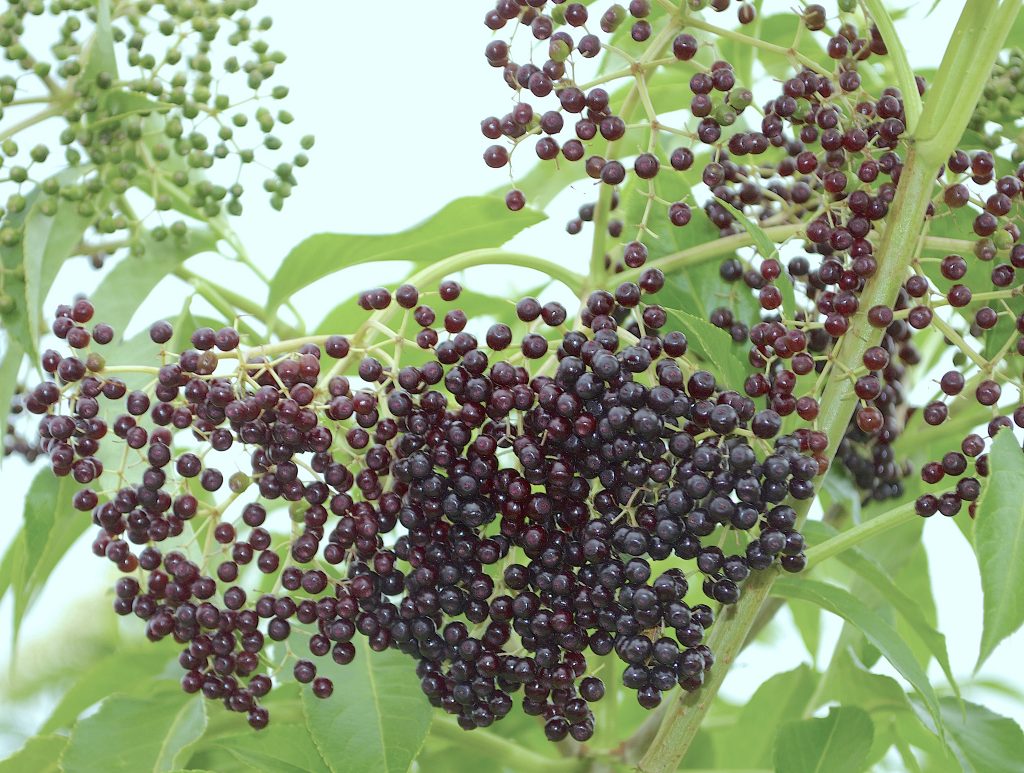
Elderberries always look better than they taste. Photo by Green Deane
This week’s debatable question is “can you eat elderberries raw?” I also call it “arguable” because no matter whether I say yes or no someone will email me and tell me I’m wrong. My answer is yes, and no which means I will irritate both sides. There are a few variables but it’s fairly easy to sort out.
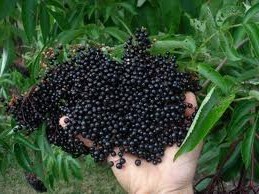
A handful of delicious? Photo by Green Deane
Elderberries contain two kinds of toxins, an alkaloid and cyanide-producing glucosides. The alkaloid is present in unripe berries. It is not a problem in ripe berries but ripe berries still have the cyanide-producing glucosides. If we are referring to dark purple elderberries, such as Sambucus canadensis or Sambucus Mexicana, the answer is yes, you can eat a few if you are an adult, very few if you are a child. If we are talking about red elderberries (Sambucus pubens and Sambucus racemosa ) the answer is definitely no regardless of your size. You can only eat the cooked pulp of red elderberries and then no seeds. Red elderberries were a staple of some Native Americans but only after much processing. In shirt-sleeve language the cyanide-producing glucosides is usually sugar and cyanide bonded together which break apart on digestion producing a small amount of hydrocyanic acid aka prussic acid… cyanide. Your body can tolerate some cyanide. Thus eating raw ripe berries becomes a function of how many of these molecules there are, how much you ate of them, how large are you and how much water there is in your digestive system which probably relates to how quickly you digest them which means how quickly is that cyanide release. A few raw ripe berries usually does not bother an adult any more than eating half-a-dozen apple seed. More than a few ripe purple elderberries can make a child ill usually with digestive upset and vomiting. Same with an adult. Raw elderberries are well-known to cause nausea. Cooking (or drying) ripe purple elderberries eliminates the problem completely. I’ve eaten a tablespoon of raw ripe purple elderberries at a time and not been bothered. But, I know of many adults who have eaten a handful and gotten sick, not at death-door’s-ill but sick nonetheless. The amount of toxicity is considered mild which means little when you’re feeling lousy.
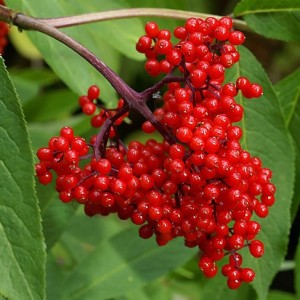
Red Elderberries are mostly toxic.
Ripe Red Elderberries are different than purple ones. They have much more potential cyanide material in their seeds and cooking does not get rid of that problem completely. That is why Native Americans ate only cooked red elderberries with the seeds removed, a labor-intensive process. Said another way red elderberry seeds cannot be eaten raw or cooked but red elderberry pulp can be eaten after cooking, and even that is debatable. So the answer is yes you can eat some ripe, raw purple elderberries but no you should not eat a lot, if only to be safe. Personally I think ripe dark purple elderberries taste far better dried or cooked than raw. Drying or cooking drives off a musty quality they tend to have and improves the flavor. Let me also give you an example using elderberries why on the Green Deane Forum, my Facebook pages and here Wikipedia is not allowed to be referenced (because it is so inaccurate about wild edibles.) Supposedly referencing an article by the Center for Disease Control Wikipedia reports. “In 1984, a group of twenty-five people were sickened, apparently by elderberry juice pressed from fresh, uncooked Sambucus mexicana berries. All recovered quickly, however, including one individual who was hospitalized after drinking five glasses. Such reported incidents are rare.” What does the report really say? The incident was in 1983 not 1984. Twenty-five people were at the event, not 25 taken ill. Eleven people were sickened, eight were flown to the hospital. One stayed overnight. The “juice” was not made from just elderberries but elderberries, elderberry stems, and elderberry leaves (as well as apple juice, sugar and water.) The juice also sat for two days before being consumed. The report does not say the elderberries were “unripe.” This is exactly why you cannot trust Wikipedia for foraging information.
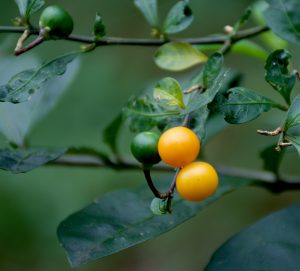
The controversial two-leaf nightshade. Photo by Green Deane
What are we to do with the Two-Leaf Nightshade, Solanum diphyllum? This native to Mexico and Central America was first spied in the United States in Miami in the early to mid-1960s. It has spread since then and is a common shrub in south and Central Florida as well as parts of Texas and in southern France, Italy and Taiwan. It’s almost always reported as toxic. I wrote “almost” because some people say they have eaten a few ripe berries without noticeable issue. In fact I have seen people eat yellow-ripe berries. They say it tastes like papaya. Our usual sources of plant expertise are no help with this greenery: Daniel Austin in his tome Florida Ethnobotany doesn’t mention the plant though he was a professor of botany in south Florida when the species was proliferating. His University of Miami boss, the crusty Julia Morton, doesn’t do us much better.
In her book Plants Poisonous To People in Florida she calls it Amatillo. Instead of having it in the main section of the book it’s in the back under “other toxins.” After a description she writes: “The ripe fruit is sweetish, not acrid like the Jerusalem Cherry, but the green fruit and leave probably contain solanine.” She adds “In one pasture, where there were several of these bushes, a horse had optical abnormality, was staggering and weak in the hindquarters and may have grazed on the foliage.” I think that means don’t eat the leaves. Morton finishes her entry with “We must regard it with suspicion until we have actual evidence of toxicity.” I would add the species in not mentioned in the Journal of Economic Botany which spans some seven decades and was created to bring lesser-known plants to public attention and use. Not only is there a dearth of credible references regarding edibility reports fall short in the medicinal realm as well. An “Amatillo” is mentioned in Duke’s Handbook of Medicinal Plants of Latin America. Unfortunately it is a totally different species, Rauvolfia tetraphylla. Apparently there are several species commonly called “Amatillo.” No doubt there is a grandmother in Central America who knows exactly what to do with Solanum diphyllum. As a Nightshade it probably has some uses. The species might be mentioned in some Spanish texts but while I can misspell in two languages Spanish is not one of them.

Foraging classes are held rain, shine, hot or cold. Photo by Nermina Krenata
Foraging classes: On the north end of the state this weekend.
Saturday, May 29th, Boulware Springs Park, 3420 SE 15th St., Gainesville, FL 32641. Meet at the picnic tables next to the pump house. 9 a.m. to noon.
Sunday, May 30th, Tide Views Preserve, 1 Begonia Street, Atlantic Beach Fl 32233 (near Jacksonville Fl.) 9 to noon. Meet at the parking lot.
Saturday, June 5th, John Chestnut County Park: 2200 East Lake Road, Palm Harbor, FL 34685. Meet at the trail head of the Peggy Park Nature Walk, pavilion 1 parking lot. 9 a.m. to noon.
Sunday, June 6th, Mead Garden: 1500 S. Denning Dr., Winter Park, FL 32789. 9 a.m. to noon. Meet at the bathrooms. Entrance to the park is on Denning.
Saturday, June 12th, Dreher Park, 1200 Southern Blvd., West Palm Beach, 33405. 9 a.m. to noon. Meet just north of the science center.
Sunday, June 13th, Bayshore Live Oak Park, Bayshore Drive. Port Charlotte. 9 a.m to noon, meet at the parking lot at Ganyard and Bayshore.
For more information, to prepay or sign up for a class go here.
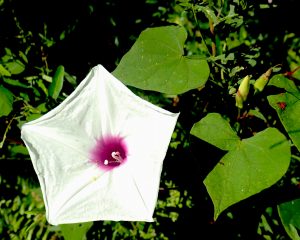
Always investigate Morning Glories that have big white blossoms. Photo by Green Deane
While on the beach I noticed a blossoming Morning Glory. I knew instantly that it would be one I would be interested in. Why? Let me tell you what I tell my foraging classes. After about 40 years of foraging I was organizing my Morning Glory information one day. Some are edible, some are famine food — eaten now and then or in small quantities — and some are mind altering. I did not have a flash of brilliance but one of color. Species of Morning Glories with blue blossoms are usually not edible, often can make you ill while simultaneously getting you high by having the LS part of LSD. Species of Morning Glories with pink blossoms are usually not edible and or are a famine food, kind of 50/50, some edible in small amounts for a while, some not edible at all. They tend to be coastal or ornamental. And I ignore small white Morning Glory blossom or small white Morning Glories with a ruby throat. However… large white Morning Glory blossoms or large white Morning Glory blossoms with a ruby throat usually have something edible. Large in this case means blossom at least three to four inches long or longer. Which part is edible depends upon the species. You can read about them here.

Green Deane videos are now available on a USB.
150-video USB would be a good spring present and is now $99. My nine-DVD set of 135 videos has been phased out. The USB videos are the same videos I have on You Tube. Some people like to have their own copy. The USB videos have to be copied to your computer to play. If you want to order the USB go to the DVD/USB order button on the top right of this page. That will take you to an order form. I’d like to thank all of you who ordered the DVD set over the years which required me to burn over 5,000 DVDs individually.

Green Deane Forum
Want to identify a plant? Perhaps you’re looking for a foraging reference? You might have a UFO, an Unidentified Flowering Object, you want identified. On the Green Deane Forum we — including Green Deane and others from around the world — chat about foraging all year. And it’s not just about warm-weather plants or just North American flora. Many nations share common weeds so there’s a lot to talk. There’s also more than weeds. The reference section has information for foraging around the world. There are also articles on food preservation, and forgotten skills from making bows to fermenting food.
 Your donations to upgrade the EatTheWeeds website and fund a book were appreciated. A book manuscript has been turned it. It had 425 articles, 1326 plants and a third of a million words. What it will be when the publisher is done with it next year is unknown. It will be published in the spring of 2023. Writing it took a significant chunk of time out of my life from which I have still not recovered. (Many things got put off.) The next phase is to update all the content on the website between now and publication date. Also note as it states above the 135-video DVD set has been phased out for 150-video USB. Times and formats change. Which reminds me I need to revisit many plants and make some new videos.
Your donations to upgrade the EatTheWeeds website and fund a book were appreciated. A book manuscript has been turned it. It had 425 articles, 1326 plants and a third of a million words. What it will be when the publisher is done with it next year is unknown. It will be published in the spring of 2023. Writing it took a significant chunk of time out of my life from which I have still not recovered. (Many things got put off.) The next phase is to update all the content on the website between now and publication date. Also note as it states above the 135-video DVD set has been phased out for 150-video USB. Times and formats change. Which reminds me I need to revisit many plants and make some new videos.
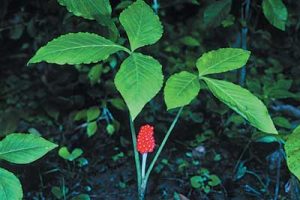
Jack in the Pulpit. Photo by Green Deane
Jack In The Pulpit are strange plants. They’re listed amongst the edible species but they are barely edible. They also readily change sex. After reproducing they become males and do nothing but hang out on the forest floor drinking sunlight and making starch. When enough energy is collected for reproduction they become females… It’s not a species that does much dating. They are usually found in damp areas with dappled sunlight. To read more about Jacks you can go here.
This is weekly newsletter #458. If you want to subscribe to this free newsletter you can find the sign-up form in the menu at the top of the page.
To donate to the Green Deane Newsletter click here.


Boy I will buy your book so fast sir, it will make your head spin! I too am so frustrated by all the bad information on foraging and plants in general. You are one of the very very few precious sources of true real information on this planet and I am extremely thankful for what you do. I will also be buying all of your videos soon! Thanks for the article!